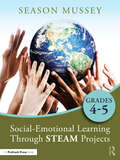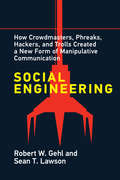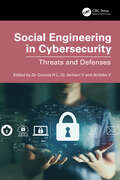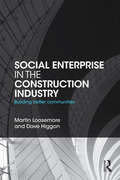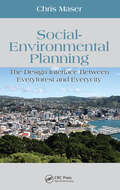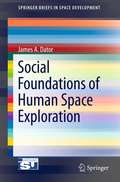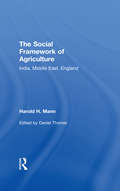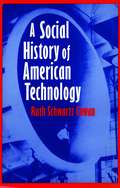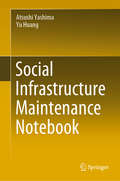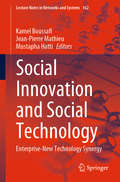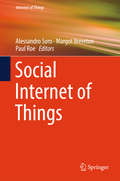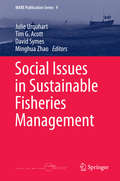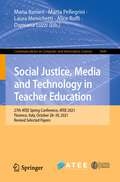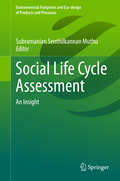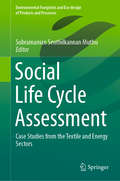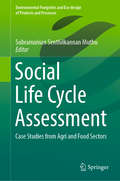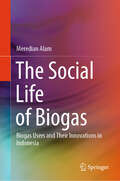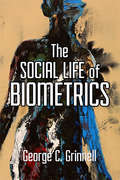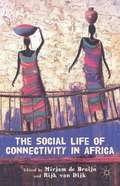- Table View
- List View
Social-Emotional Learning Through STEAM Projects, Grades 4-5
by Season MusseySocial-Emotional Learning Through STEAM Projects, Grades 4–5 helps educators target the development of social and emotional learning (SEL) competencies for high-ability learners through interdisciplinary, project-based inquiry. Aligned with STEAM content standards, each of the nine projects introduces students to a real-world problem through essential questions and the presentation of a primary source document. Both the content and the inquiry process support SEL competency development, from self-awareness to selfmanagement, social awareness, relationship skills, and responsible decision-making. As students work to understand and pose solutions to each problem, they gain the knowledge and practical skills needed to become more socially and emotionally competent individuals in their classroom communities.
Social Engineering: How Crowdmasters, Phreaks, Hackers, and Trolls Created a New Form of Manipulativ e Communication
by Robert W. Gehl Sean T. LawsonManipulative communication—from early twentieth-century propaganda to today&’s online con artistry—examined through the lens of social engineering. The United States is awash in manipulated information about everything from election results to the effectiveness of medical treatments. Corporate social media is an especially good channel for manipulative communication, with Facebook a particularly willing vehicle for it. In Social Engineering, Robert Gehl and Sean Lawson show that online misinformation has its roots in earlier techniques: mass social engineering of the early twentieth century and interpersonal hacker social engineering of the 1970s, converging today into what they call &“masspersonal social engineering.&” As Gehl and Lawson trace contemporary manipulative communication back to earlier forms of social engineering, possibilities for amelioration become clearer. The authors show how specific manipulative communication practices are a mixture of information gathering, deception, and truth-indifferent statements, all with the instrumental goal of getting people to take actions the social engineer wants them to. Yet the term &“fake news,&” they claim, reduces everything to a true/false binary that fails to encompass the complexity of manipulative communication or to map onto many of its practices. They pay special attention to concepts and terms used by hacker social engineers, including the hacker concept of &“bullshitting,&” which the authors describe as a truth-indifferent mix of deception, accuracy, and sociability. They conclude with recommendations for how society can undermine masspersonal social engineering and move toward healthier democratic deliberation.
Social Engineering in Cybersecurity: Threats and Defenses
by Dr Gururaj H L Dr Janhavi V Ambika VIn today’s digitally interconnected world, the threat landscape has evolved to include not just sophisticated technical exploits but also the art of human manipulation. Social engineering attacks have emerged as a formidable and often underestimated threat to information security. The primary aim of this textbook is to provide a comprehensive and in-depth exploration of social engineering attacks. The book seeks to equip cybersecurity professionals, IT practitioners, students, and anyone concerned with information security with the knowledge and tools needed to recognize, prevent, and mitigate the risks posed by social engineering. The scope of this textbook is broad and multifaceted. It covers a wide range of social engineering attack vectors, including phishing, vishing, pretexting, baiting, tailgating, impersonation, and more. Each attack vector is dissected, with detailed explanations of how they work, real-world examples, and countermeasures. Key Features • Comprehensive Coverage: Thorough exploration of various social engineering attack vectors, including phishing, vishing, pretexting, baiting, quid pro quo, tailgating, impersonation, and more. • Psychological Insights: In-depth examination of the psychological principles and cognitive biases that underlie social engineering tactics. • Real-World Case Studies: Analysis of real-world examples and high-profile social engineering incidents to illustrate concepts and techniques.• Prevention and Mitigation: Practical guidance on how to recognize, prevent, and mitigate social engineering attacks, including security best practices. • Ethical Considerations: Discussion of ethical dilemmas and legal aspects related to social engineering that emphasizes responsible use of knowledge. This comprehensive textbook on social engineering attacks provides a deep and practical exploration of this increasingly prevalent threat in cybersecurity. It covers a wide array of attack vectors, including phishing, vishing, pretexting, and more, offering readers an in-depth understanding of how these attacks work. The book delves into the psychology behind social engineering and examines the cognitive biases and emotional triggers that make individuals susceptible. Real-world case studies illustrate concepts and techniques while practical guidance equips readers with the knowledge to recognize, prevent, and mitigate social engineering threats.
Social Enterprise in the Construction Industry: Building Better Communities
by Martin Loosemore Dave HiggonThrough the emerging lens of social enterprise, this book examines how the global construction industry can engage more effectively with the communities in which it builds, addressing disadvantage and environmental degradation to leave a positive legacy for future generations. Combining insights from leading research and real-life case studies of social enterprise in the construction sector, the result is a practical framework which will help social enterprises, clients, consultants and construction firms work collectively to build a thriving social enterprise sector. Readers of this timely book will learn to embrace social enterprise and an important new sector in the global construction industry. They will learn to see community involvement as an opportunity rather than a risk, and fully understand the broader role they can play in building a fairer and more sustainable society.
Social-Environmental Planning: The Design Interface Between Everyforest and Everycity (Social Environmental Sustainability)
by Chris MaserWith the environment, climate change, and global warming taking center stage in the national debate, the issues seem insurmountable and certainly unsolvable at the local level. Written by Chris Maser, international consultant on forest ecology, sustainable forestry practices, and sustainable development, Social-Environmental Planning: The Design In
Social Foundations of Human Space Exploration
by James A. DatorThis title presents a uniquely human perspective on the quest to explore space and to understand the universe through the lens of the arts, humanities, and social sciences. It considers early stories about the universe in various cultures; recent space fiction; the origins and cultural rationale for the space age; experiences of humans in space and their emerging interactions with robots and artificial intelligence; how humans should treat environments and alien life; and the alternative futures of space exploration and settlement.
Social Framework of Agriculture: India, Middle East, England (Routledge Revivals Ser.)
by Harold H. MannFirst Published in 1968. Dr. Harold H. Mann was during his lifetime an acknowledged authority on applied science and agriculture in England, the Middle East and India, but it is less widely known that he was equally distinguished by his work in the social sciences. He not only pioneered modern-style village surveys in both England and India, but also modern style urban surveys and studies in India. There he broke new ground in his remarkable first-hand research on agricultural labour, village economics, depressed or “Untouchable” classes in town and country, and human and industrial relations in India’s first steel town, Jamshedpur. This book reproduces thirty-five of Dr. Mann’s papers—in whole, in part, or in summary.
A Social History of American Technology
by Ruth Schwartz Cowan(back of book) For over 250 years American technology has been regarded as a unique hallmark of American culture and an important factor in American prosperity. Despite this, American history has rarely been told from the perspective of the history of technology. A Social History of American Technology fills this gap by surveying the history of American technology from the tools used by the earliest native inhabitants to the technological systems- cars and computers, aircraft and antibiotics- we are familiar with today. Cowan makes use of the most recent scholarship to explain how the unique characteristics of American cultures and American geography have affected the technologies that have been invented, manufactured, and used throughout the years. She also focuses on the key individuals and ideas that have shaped important technological developments. The text explains how various technologies have affected the ways in which Americans work, govern, cook, transport, communicate, maintain their health, and reproduce. Cowan demonstrates that technological change has always been closely related to social development, and explores the multiple, complex relationships that have existed between such diverse social agents as households and businesses, the scientific community and the defense establishment, artists and inventors. Divided into three sections- colonial America. industrialization, the 20th century- A Social History of American Technology is ideal for courses in American social and economic history, as a correlated text for the American history survey, as well as for courses that focus on the history of technology. It offers students the unique opportunity to learn not only how profoundly technological change has affected the American way of life, but how profoundly the American way of life has affected technology.
Social Infrastructure Maintenance Notebook
by Atsushi Yashima Yu HuangThis book explains in an easy-to-understand manner the “check” points to keep in mind when inspecting various social infrastructure structures. It is put together in a way that not only engineers who are on the front line of maintenance and management but also engineers who are not normally involved in maintenance and management of social infrastructures as well as general public can understand the importance of social infrastructure inspection work.
Social Innovation and Social Technology: Enterprise-New Technology Synergy (Lecture Notes in Networks and Systems #162)
by Kamel Boussafi Jean-Pierre Mathieu Mustapha HattiThis proceedings book is of interest to all researchers and heads of technology laboratories; incubator managers; local and parliamentary elected officials; associations and civil society; social entrepreneurs; foundations interested in social life in Mediterranean region and prospective creative startup students. The purpose of book on social and social-tech innovation synergy and its practical implication on social entrepreneurship is to address the following question: - How can the experiences of the countries be combined of the north and south shores of the Mediterranean and reflect on the different opportunities offered by the new technology to cope with the various social scourges that the region has experienced in recent years? the problem of immigration. It is also about finding advanced technology applications that will solve, on a large scale, the major social challenges of our time. - How to exploit the innumerable synergies between digital and social entrepreneurship? - Why social entrepreneurs are struggling to seize digital tools to develop their socially innovative projects? - What about their ability to integrate digital into the realization and development of these projects? - How can we combine the experiences of the countries of the north and south shores of the Mediterranean and reflect on the different opportunities offered by the new technology to cope with the various social scourges that the region has experienced in recent years? the problem of immigration.
Social Innovation in Long-Term Care Through Digitalization: Proceedings of the German-Italian Workshop LTC-2021 (Lecture Notes in Bioengineering)
by Massimo Conti Simone OrcioniThis book gathers extended contributions to the workshop on Long-Term Digital Care, LTC-2021, organized by the Università Politecnica delle Marche (UNIVPM), Ancona, Italy, and the Hochschule Konstanz (HTWG), Germany, in November 2021, and funded by the DAAD Joint Mobility Program. It covers innovative, practice-oriented approaches that are expected to foster digital health care, with a special focus on improving internationalization and accessibility. The book, which bridges between technological and social disciplines, reports on selected studies with the main goals of: establishing a comparison of Long-Term Digital Care approaches, with focus on exchange and networking processes; defining practical roadmaps for digital social innovation; establishing concepts and methods for process evaluation and sustainability. It offers a timely snapshot on technologies for patient monitoring and assistant systems, medical data analysis and image processing, digital platforms and advanced diagnostics techniques, and discusses important concepts relating to traceable process evaluation, networking and accessibility. It aims at informing, yet it is also intended to inspire and foster a stronger collaboration across disciplines, countries, as well as academic and professional institutions.
Social Internet of Things (Internet of Things)
by Alessandro Soro Margot Brereton Paul RoeThe aim of this book is to stimulate research on the topic of the Social Internet of Things, and explore how Internet of Things architectures, tools, and services can be conceptualized and developed so as to reveal, amplify and inspire the capacities of people, including the socialization or collaborations that happen through or around smart objects and smart environments. From new ways of negotiating privacy, to the consequences of increased automation, the Internet of Things poses new challenges and opens up new questions that often go beyond the technology itself, and rather focus on how the technology will become embedded in our future communities, families, practices, and environment, and how these will change in turn.
Social Issues in Sustainable Fisheries Management
by Julie Urquhart Tim G. Acott David Symes Minghua ZhaoThis volume is an interdisciplinary mix of perspectives and studies on social issues in fisheries from a diverse range of case studies and research disciplines. The case is made regarding the dearth of attention to socio-cultural considerations which to date have been largely treated as an externality of fisheries policy. It will be valuable to researchers and decision makers interested in understanding the social dimension of fisheries and provides a timely and relevant compilation of research and analysis on some of the critical socio-cultural issues facing fisheries management and fishing communities today.
Social Justice, Media and Technology in Teacher Education: 27th ATEE Spring Conference, ATEE 2021, Florence, Italy, October 28–29, 2021, Revised Selected Papers (Communications in Computer and Information Science #1649)
by Maria Ranieri Marta Pellegrini Laura Menichetti Alice Roffi Damiana LuzziThis book constitutes the refereed proceedings of the 27th ATEE Spring Conference onSocial Justice, Media and Technology, ATEE 2021, held in Florence, Italy, during October 28–30, 2021.The 19 full papers included in this book were carefully reviewed and selected from 49 submissions. They were organized in topical sections as follows: teaching critical media/digital literacy in multicultural societies; decommodifying teacher (digital) education; and digital technology and equity for inclusive teaching.
Social Life Cycle Assessment
by Subramanian Senthilkannan MuthuThis book details the primary concepts of Social Life Cycle Assessment (S-LCA), integration of social aspects in product life cycles, quantification of social impacts in S-LCA, impact categorization in S-LCA, methodological aspects of S-LCA, and detailed case studies. As the societal implications of producing a product are coming to take on a new importance, the concept of Social Life Cycle Assessment has recently been developed and is becoming increasingly prominent. However, S-LCA is still in its infancy and its impact categories for many industrial segments are still under development.
Social Life Cycle Assessment: Case Studies from the Textile and Energy Sectors (Environmental Footprints and Eco-design of Products and Processes)
by Subramanian Senthilkannan MuthuThis book highlights the Social Life Cycle Assessment (SLCA) of the energy and textile sectors. It also presents a range of models, indices, impact categories, etc. for SLCA that are currently being developed for industrial applications. Though SLCA was introduced in 2010, it is still relatively new compared to environmental life cycle assessment (ELCA).
Social Life Cycle Assessment: Case Studies from Agri and Food Sectors (Environmental Footprints and Eco-design of Products and Processes)
by Subramanian Senthilkannan MuthuThis book highlights the Social Life Cycle Assessment (SLCA) of the agri-sector for rice, sugarcane, and cassava in Thailand and the food sector. It also presents a range of models, indices, impact categories, etc. for SLCA that are currently being developed for industrial applications. Though SLCA was introduced in 2010, it is still relatively new compared to environmental life cycle assessment (ELCA).
The Social Life of Biogas: Biogas Users and Their Innovations in Indonesia
by Meredian AlamThis is the most comprehensive book discussing the impact of renewable energy transition by engaging local narratives, and combining this with the domestication of technology theory. Addressing a specific concern, the discussion considers the development of household biogas from an interdisciplinary sociological perspective and addresses the success factors for the implementation of biogas policy on the household level in Indonesia. Drawing upon extensive ethnographic fieldwork in a rural Indonesia, this book explores the interactive process of social and technological innovation from a user perspective. Their social interactions with wider stakeholders such as biogas technology trainers, laborers, construction partner organizations, and fellow users are examined. The author sheds light on emerging evidence around biogas sustainability by engaging a unique interdisciplinary framework that combines aspects of both sociology and engineering. Offering a unique insight, this book is relevant for social scientists, postgraduate students, social workers, environmental activists, communication experts, and engineers working across aspects of renewable energy development. They will gain new interdisciplinary insights and applicable approaches to building household biogas by actively engaging the users.
The Social Life of Biometrics
by George C GrinnellIn The Social Life of Biometrics, biometrics is loosely defined as a discrete technology of identification that associates physical features with a legal identity. Author George Grinnell considers the social and cultural life of biometrics by examining what it is asked to do, imagined to do, and its intended and unintended effects. As a human-focused account of technology, the book contends that biometrics needs to be understood as a mode of thought that informs how we live and understand one another; it is not simply a neutral technology of identification. Placing our biometric present in historical and cultural perspective, The Social Life of Biometrics examines a range of human experiences of biometrics. It features individual stories from locations as diverse as Turkey, Canada, Qatar, Six Nations territory in New York State, Iraq, the skies above New York City, a university campus and Nairobi to give cultural accounts of identification and look at the ongoing legacies of our biometric ambitions. It ends by considering the ethics surrounding biometrics and human identity, migration, movement, strangers, borders, and the nature of the body and its coherence. How has biometric thought structured ideas about borders, race, covered faces, migration, territory, citizenship, and international responsibility? What might happen if identity was less defined by the question of “who’s there?” and much more by the question “how do you live?”
The Social Life of Connectivity in Africa
by Mirjam De Bruijn Rijk Van DijkThe rapid increase in adoption of modern 'connective' technologies like the mobile phone has reshaped the social landscape of Africa. This book examines the myriad possibilities that the post-global moment offers African societies to develop and to relate, offering profound new insights into the processes of globalization.
The Social Life of DNA
by Alondra NelsonThe unexpected story of how genetic testing is affecting race in AmericaWe know DNA is a master key that unlocks medical and forensic secrets, but its genealogical life is both revelatory and endlessly fascinating. Tracing genealogy is now the second-most popular hobby amongst Americans, as well as the second-most visited online category. This billion-dollar industry has spawned popular television shows, websites, and Internet communities, and a booming heritage tourism circuit.The tsunami of interest in genetic ancestry tracing from the African American community has been especially overwhelming. In The Social Life of DNA, Alondra Nelson takes us on an unprecedented journey into how the double helix has wound its way into the heart of the most urgent contemporary social issues around race.For over a decade, Nelson has deeply studied this phenomenon. Artfully weaving together keenly observed interactions with root-seekers alongside illuminating historical details and revealing personal narrative, she shows that genetic genealogy is a new tool for addressing old and enduring issues. In The Social Life of DNA, she explains how these cutting-edge DNA-based techniques are being used in myriad ways, including grappling with the unfinished business of slavery: to foster reconciliation, to establish ties with African ancestral homelands, to rethink and sometimes alter citizenship, and to make legal claims for slavery reparations specifically based on ancestry.Nelson incisively shows that DNA is a portal to the past that yields insight for the present and future, shining a light on social traumas and historical injustices that still resonate today. Science can be a crucial ally to activism to spur social change and transform twenty-first-century racial politics. But Nelson warns her readers to be discerning: for the social repair we seek can't be found in even the most sophisticated science. Engrossing and highly original, The Social Life of DNA is a must-read for anyone interested in race, science, history and how our reckoning with the past may help us to chart a more just course for tomorrow.From the Hardcover edition.
Social Manufacturing: Fundamentals and Applications (Springer Series in Advanced Manufacturing)
by Pingyu JiangThis book introduces social manufacturing, the next generation manufacturing paradigm that covers product life cycle activities that deal with Internet-based organizational and interactive mechanisms under the context of socio-technical systems in the fields of industrial and production engineering. Like its subject, the book's approach is multi-disciplinary, including manufacturing systems, operations management, computational social sciences and information systems applications. It reports on the latest research findings regarding the social manufacturing paradigm, the architecture, configuration and execution of social manufacturing systems and more. Further, it describes the individual technologies enabled by social manufacturing for each topic, supported by case studies. The technologies discussed include manufacturing resource minimalization and their socialized reorganizations, blockchain models in cybersecurity, computing and decision-making, social business relationships and organizational networks, open product design, social sensors and extended cyber-physical systems, and social factory and inter-connections. This book helps engineers and managers in industry to practice social manufacturing, as well as offering a systematic reference resource for researchers in manufacturing. Students also benefit from the detailed discussions of the latest research and technologies that will have been put into practice by the time they graduate.
Social Media: Dominating Strategies For Social Media Marketing with Twitter, Facebook, YouTube and Instagram
by Michael RichardsEvery business owner or marketing executive now agrees to the fact that their business has to adapt to social media or end up losing touch with its customers. In this book we dissect and provide you with the best proven strategies that will help you take over all aspects of Social Media.
Social Media Analytics and Practical Applications: The Change to the Competition Landscape (Emerging Operations Research Methodologies and Applications)
by Subodha Kumar Liangfei QiuSocial Media Analytics and Practical Applications: The Change to the Competition Landscape provides a framework that allows you to understand and analyze the impact of social media in various industries. It illustrates how social media analytics can help firms build transformational strategies and cope with the challenges of social media technology. By focusing on the relationship between social media and other technology models, such as wisdom of crowds, healthcare, fintech and blockchain, machine learning methods, and 5G, this book is able to provide applications used to understand and analyze the impact of social media. Various industries are called out and illustrate how social media analytics can help firms build transformational strategies and at the same time cope with the challenges that are part of the landscape. The book discusses how social media is a driving force in shaping consumer behavior and spurring innovations by embracing and directly engaging with consumers on social media platforms. By closely reflecting on emerging practices, the book shows how to take advantage of recent advancements and how business operations are being revolutionized. Social Media Analytics and Practical Applications is written for academicians and professionals involved in social media and social media analytics.
Social Media Analytics for User Behavior Modeling: A Task Heterogeneity Perspective (Data-Enabled Engineering)
by Arun Reddy Nelakurthi Jingrui HeWinner of the "Outstanding Academic Title" recognition by Choice for the 2020 OAT Awards. The Choice OAT Award represents the highest caliber of scholarly titles that have been reviewed by Choice and conveys the extraordinary recognition of the academic community. In recent years social media has gained significant popularity and has become an essential medium of communication. Such user-generated content provides an excellent scenario for applying the metaphor of mining any information. Transfer learning is a research problem in machine learning that focuses on leveraging the knowledge gained while solving one problem and applying it to a different, but related problem. Features: Offers novel frameworks to study user behavior and for addressing and explaining task heterogeneity Presents a detailed study of existing research Provides convergence and complexity analysis of the frameworks Includes algorithms to implement the proposed research work Covers extensive empirical analysis Social Media Analytics for User Behavior Modeling: A Task Heterogeneity Perspective is a guide to user behavior modeling in heterogeneous settings and is of great use to the machine learning community.
